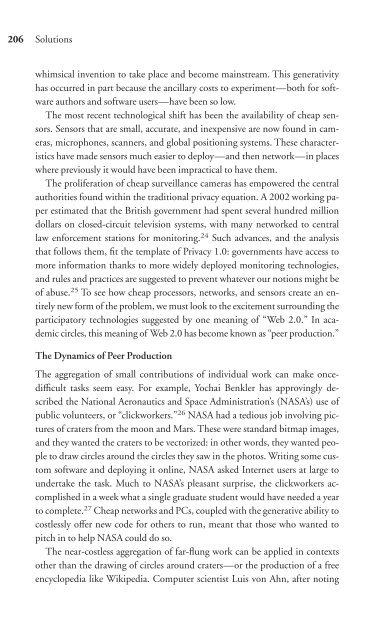Download - Future of the Internet â And how to stop it.
Download - Future of the Internet â And how to stop it.
Download - Future of the Internet â And how to stop it.
Create successful ePaper yourself
Turn your PDF publications into a flip-book with our unique Google optimized e-Paper software.
206<br />
Solutions<br />
whimsical invention <strong>to</strong> take place and become mainstream. This generativ<strong>it</strong>y<br />
has occurred in part because <strong>the</strong> ancillary costs <strong>to</strong> experiment—both for s<strong>of</strong>tware<br />
authors and s<strong>of</strong>tware users—have been so low.<br />
The most recent technological shift has been <strong>the</strong> availabil<strong>it</strong>y <strong>of</strong> cheap sensors.<br />
Sensors that are small, accurate, and inexpensive are now found in cameras,<br />
microphones, scanners, and global pos<strong>it</strong>ioning systems. These characteristics<br />
have made sensors much easier <strong>to</strong> deploy—and <strong>the</strong>n network—in places<br />
where previously <strong>it</strong> would have been impractical <strong>to</strong> have <strong>the</strong>m.<br />
The proliferation <strong>of</strong> cheap surveillance cameras has empowered <strong>the</strong> central<br />
author<strong>it</strong>ies found w<strong>it</strong>hin <strong>the</strong> trad<strong>it</strong>ional privacy equation. A 2002 working paper<br />
estimated that <strong>the</strong> Br<strong>it</strong>ish government had spent several hundred million<br />
dollars on closed-circu<strong>it</strong> television systems, w<strong>it</strong>h many networked <strong>to</strong> central<br />
law enforcement stations for moni<strong>to</strong>ring. 24 Such advances, and <strong>the</strong> analysis<br />
that follows <strong>the</strong>m, f<strong>it</strong> <strong>the</strong> template <strong>of</strong> Privacy 1.0: governments have access <strong>to</strong><br />
more information thanks <strong>to</strong> more widely deployed moni<strong>to</strong>ring technologies,<br />
and rules and practices are suggested <strong>to</strong> prevent whatever our notions might be<br />
<strong>of</strong> abuse. 25 To see <strong>how</strong> cheap processors, networks, and sensors create an entirely<br />
new form <strong>of</strong> <strong>the</strong> problem, we must look <strong>to</strong> <strong>the</strong> exc<strong>it</strong>ement surrounding <strong>the</strong><br />
participa<strong>to</strong>ry technologies suggested by one meaning <strong>of</strong> “Web 2.0.” In academic<br />
circles, this meaning <strong>of</strong> Web 2.0 has become known as “peer production.”<br />
The Dynamics <strong>of</strong> Peer Production<br />
The aggregation <strong>of</strong> small contributions <strong>of</strong> individual work can make oncedifficult<br />
tasks seem easy. For example, Yochai Benkler has approvingly described<br />
<strong>the</strong> National Aeronautics and Space Administration’s (NASA’s) use <strong>of</strong><br />
public volunteers, or “clickworkers.” 26 NASA had a tedious job involving pictures<br />
<strong>of</strong> craters from <strong>the</strong> moon and Mars. These were standard b<strong>it</strong>map images,<br />
and <strong>the</strong>y wanted <strong>the</strong> craters <strong>to</strong> be vec<strong>to</strong>rized: in o<strong>the</strong>r words, <strong>the</strong>y wanted people<br />
<strong>to</strong> draw circles around <strong>the</strong> circles <strong>the</strong>y saw in <strong>the</strong> pho<strong>to</strong>s. Wr<strong>it</strong>ing some cus<strong>to</strong>m<br />
s<strong>of</strong>tware and deploying <strong>it</strong> online, NASA asked <strong>Internet</strong> users at large <strong>to</strong><br />
undertake <strong>the</strong> task. Much <strong>to</strong> NASA’s pleasant surprise, <strong>the</strong> clickworkers accomplished<br />
in a week what a single graduate student would have needed a year<br />
<strong>to</strong> complete. 27 Cheap networks and PCs, coupled w<strong>it</strong>h <strong>the</strong> generative abil<strong>it</strong>y <strong>to</strong><br />
costlessly <strong>of</strong>fer new code for o<strong>the</strong>rs <strong>to</strong> run, meant that those who wanted <strong>to</strong><br />
p<strong>it</strong>ch in <strong>to</strong> help NASA could do so.<br />
The near-costless aggregation <strong>of</strong> far-flung work can be applied in contexts<br />
o<strong>the</strong>r than <strong>the</strong> drawing <strong>of</strong> circles around craters—or <strong>the</strong> production <strong>of</strong> a free<br />
encyclopedia like Wikipedia. Computer scientist Luis von Ahn, after noting


